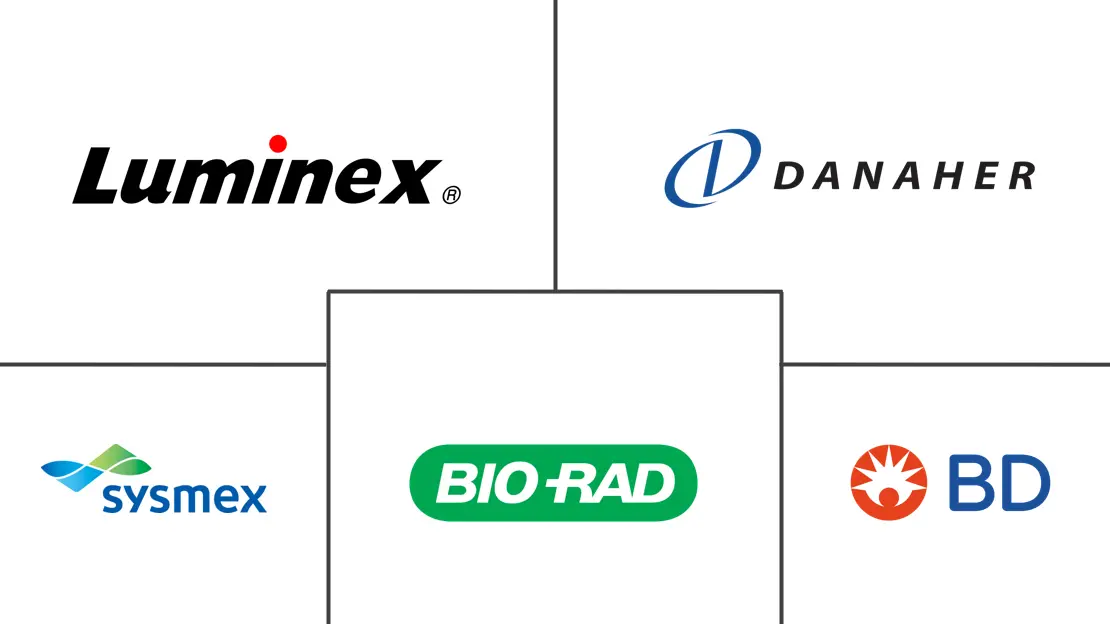Flow Cytometry Market Size and Share
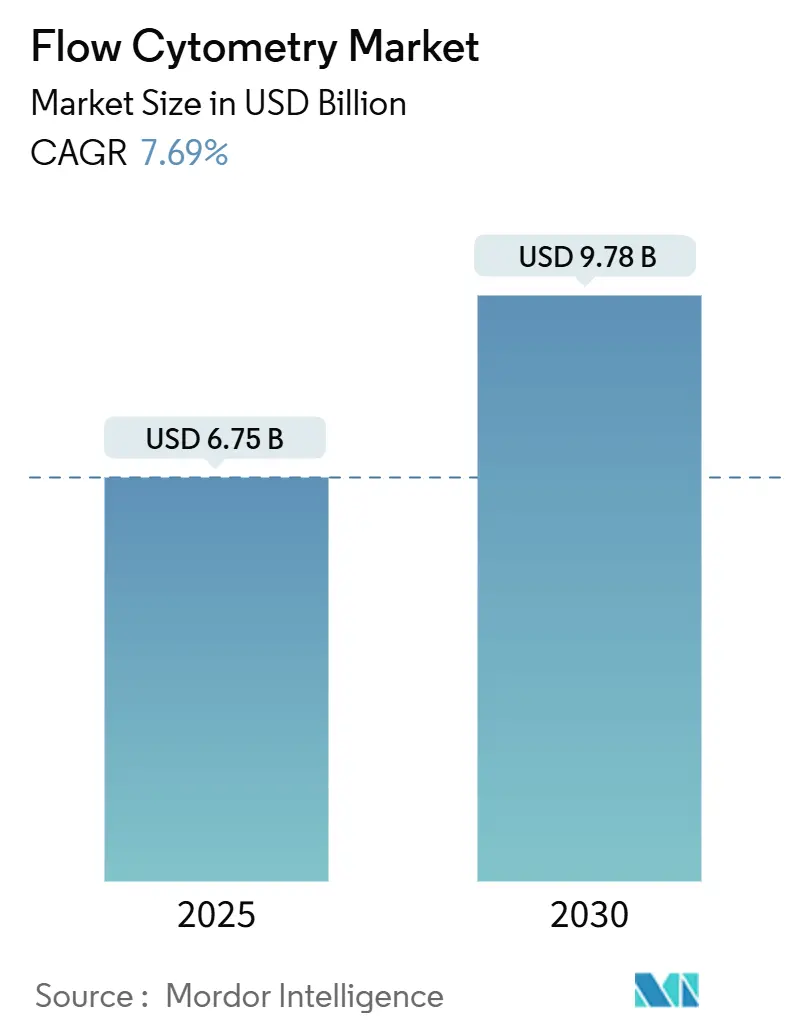
Flow Cytometry Market Analysis by Mordor Intelligence
The Flow Cytometry Market size is estimated at USD 6.75 billion in 2025, and is expected to reach USD 9.78 billion by 2030, at a CAGR of 7.69% during the forecast period (2025-2030).
Rising demand for single-cell analytics in translational research and the steady migration of high-parameter platforms into regulated laboratories underpin this expansion. Hospital consolidation in North America is sustaining instrument refresh cycles, while Asian biotechnology clusters are fuelling incremental unit sales. Intelligent software that automates panel design and gating is lowering the expertise threshold, opening fresh revenue streams in community laboratories. Vendors continue to differentiate through spectral optics, acoustic-focusing, and image-enabled sorters that compress turnaround times and expand analyte menus, positioning flow cytometry as an essential companion to multi-omics workflows.
Key Report Takeaways
- By product & service, instruments led with 34.90% revenue share in 2024; software is projected to expand at a 10.34% CAGR through 2030.
- By technology, cell-based platforms held 72.30% of flow cytometry market share in 2024, while bead-based assays are forecast to grow at a 9.80% CAGR.
- By application, clinical diagnostics accounted for 45.40% of the flow cytometry market size in 2024; stem cell therapy and regenerative medicine is the fastest-growing application at a 9.86% CAGR to 2030.
- By end-user, hospitals and clinics commanded 40.71% of 2024 revenue, whereas pharmaceutical and biotechnology companies are rising fastest with an 8.87% CAGR.
- By geography, North America dominated with a 41.20% share in 2024, while Asia-Pacific is on track for an 8.96% CAGR over the forecast period
Global Flow Cytometry Market Trends and Insights
Driver Impact Analysis
| Driver | (~) % Impact on CAGR Forecast | Geographic Relevance | Peak Impact |
|---|---|---|---|
| Growing Adoption of Flow Cytometry in Stem-Cell & Regenerative-Medicine Workflows | ~+1.2 | Global, with early acceleration in APAC and EU | Medium term (~3-4 yrs) |
| Increasing Adoption in Clinical Diagnostics | ~+1.0 | North America, EU, APAC core | Short term (≤2 yrs) |
| Advances in Flow Cytometry Tools and Techniques | ~+0.8 | Global | Medium term (~3-4 yrs) |
| Expanding Clinical Applications | ~+0.7 | Global, with oncology hotspots in US/EU | Long term (≥5 yrs) |
| Rising Use of Multi-Parametric Immuno-Oncology Panels in North America | ~+0.5 | North America | Short term (≤2 yrs) |
| Expansion of Cloud-Based Cytometry Analytics Platforms Across Europe | ~+0.4 | Europe (esp. DE, UK, FR), spill-over to APAC | Medium term (~3-4 yrs) |
| Source: Mordor Intelligence | |||
Growing adoption in stem-cell and regenerative-medicine workflows
Stem-cell laboratories rely on flow cytometry to enumerate CD34+ hematopoietic stem cells directly from minimally processed blood, reducing graft adequacy variability and accelerating transplantation decisions. Umbilical cord-blood banks have scaled globally as standardized cytometric assays safeguard inventory quality. Accurate quantification of immunologic reconstitution after transplant further solidifies cytometry’s role in long-term patient monitoring. The procedure’s direct-measurement protocol trims processing steps, enabling same-day release decisions that shorten hospitalization. As gene-edited stem-cell therapies move toward commercialization, demand for rapid in-process characterization is set to intensify, widening the installed base across cell-therapy manufacturing centers. These factors collectively reinforce the flow cytometry market trajectory among regenerative-medicine stakeholders.
Increasing adoption in clinical diagnostics
Flow cytometry now underpins immunophenotyping panels for leukemia, lymphoma, and primary-immune disorders. FDA clearance of a 13-color clinical cytometer in March 2024 reduced validation hurdles for community pathology labs. Integration with bi-directional LIS connectivity cuts manual transcription errors and satisfies accreditation requirements. Oncology testing volumes are rising as minimal residual disease assays become routine, expanding reagent consumption and service contracts. Infectious-disease labs use high-parameter panels to track rare cell subsets during viral outbreaks, a capability highlighted during recent respiratory pathogen surveillance. These clinical expansions continue to anchor recurring revenue streams and lift the aggregate flow cytometry market.
Advances in tools and techniques
Spectral optics with full-spectrum unmixing enable simultaneous detection of up to 40 markers, sharply reducing sample requirements for complex immuno-oncology trials. AI-driven panel-design software slashes planning time from weeks to minutes, mitigating operator bottlenecks. Imaging flow cytometry couples morphological insight with fluorescence intensity, revealing subtle subcellular processes crucial for cell-therapy potency assays. Acoustic-focusing refinements improve signal quality at high throughput, boosting assay precision in drug-screening pipelines. Collectively, these innovations expand experimental depth and reduce per-sample costs, accelerating flow cytometry market adoption.
Expanding clinical applications through companion diagnostics
A July 2024 alliance between a leading instrument vendor and a multinational reference lab targets development of flow-based companion diagnostics, underscoring cytometry’s emerging role in precision oncology Single-cell resolution supports faster treatment-selection cycles than bulk genomic assays, and regulatory familiarity with cytometric methods speeds assay approval. Early engagement between device firms and therapy developers is expected to normalize flow-cytometry CDx pipelines, bolstering future reagent demand and instrument placements and reinforcing confidence in the flow cytometry market.
Restraint Impact Analysis
| Restraint | (~) % Impact on CAGR Forecast | Geographic Relevance | Peak Impact |
|---|---|---|---|
| Lack of Skilled Cytometrists Driving Outsourcing to Reference Labs | ~-0.7 | Global, acute in North America & EU | Short term (≤2 yrs) |
| Stringent Reagent Registration Rules in EU MDR Impacting Time-to-Market | ~-0.6 | Europe | Medium term (~3-4 yrs) |
| High Capital Costs of Cell-Sorter Platforms Limiting Adoption in Smaller Labs | ~-0.5 | Global, with highest impact in APAC/EMEA | Short term (≤2 yrs) |
| Data-Management & Cybersecurity Concerns with Cloud-Based Workflows | ~-0.4 | North America, EU | Medium term (~3-4 yrs) |
| Source: Mordor Intelligence | |||
Lack of skilled cytometrists driving outsourcing to reference labs
Specialized teams handle validation protocols, enabling pharmaceutical sponsors to avoid building in-house capacity. Cloud-native software equipped with advanced clustering algorithms further lessens manual gating burdens, yet staff shortages persist in many regional hospitals, constraining routine adoption and tempering the flow cytometry market growth near term.
Data-management and cybersecurity concerns with cloud-based workflows
High-parameter experiments generate gigabyte-scale files that strain local storage, steering users toward cloud platforms. Clinical laboratories must comply with 21 CFR Part 11, demanding stringent audit trails and access controls. Cyber-risk mitigation adds implementation cost and lengthens procurement cycles as IT and compliance teams vet new infrastructure. Instrument makers now bundle validated electronic-record modules to address these obstacles, yet residual security concerns may defer cloud migrations, moderating market acceleration in regulated environments.
Segment Analysis
By Product & Service: Software widens performance gap with hardware
Software revenue is rising fastest at a 10.34% CAGR as laboratories prioritize intelligent analytics that trim analysis times. The flow cytometry market size for instruments remained the largest in 2024, with a 34.90% segment share secured by constant upgrades in detector sensitivity and spectral resolution. Vendors package integrated ecosystems where turnkey analysis suites lock in recurring licensing fees and encourage reagent loyalty. Analysts expect incremental growth as cloud-hosted applications reach midsized hospitals that had previously been priced out of high-parameter workflows. Meanwhile, reagents and consumables benefit from expanded dye libraries that lengthen panel lists, sustaining installed-base pull-through. These interdependent trends illustrate how software ascendance complements, rather than cannibalizes, hardware revenue across the flow cytometry market.
Instrument sales climb further as real-time imaging modules win adoption among immuno-oncology groups demanding morphological confirmation. Spectral sorters that retain viability during high-speed isolation of rare subsets are penetrating cell-therapy manufacturing suites. The co-evolution of reagent chemistries optimized for full-spectrum detection fosters vendor lock-in and drives compound annual growth above historical trajectories. Continued funding for algorithm innovation signals that intuitive analysis will remain a competitive differentiator, anchoring the long-term revenue outlook for integrated product portfolios.
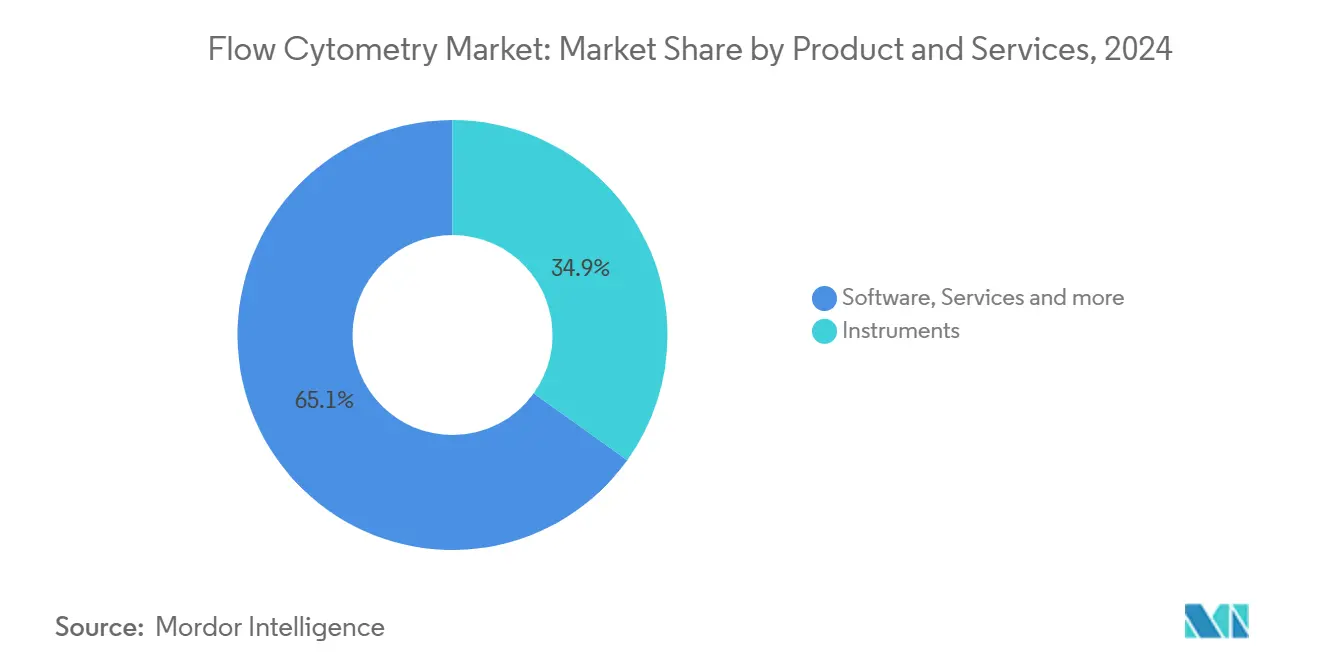
Note: Segment shares of all individual segments available upon report purchase
By Technology: Hybrid platforms merge cell-based dominance with bead-assay flexibility
Cell-based methods accounted for 72.30% of the flow cytometry market revenue in 2024, underscoring their foundational role in immunophenotyping and cell-therapy quality control. Bead-based assays, however, are on a 9.80% CAGR path as multiplex cytokine quantification gains favor in translational research. The flow cytometry market share lead of cell-based platforms stems from unmatched single-cell resolution, yet hybrid instruments capable of running both bead and cell protocols on the same optical train now appeal to budget-constrained core facilities. Imaging modules and acoustic-focusing refinements further blur segment lines by adding morphological or high-throughput benefits without abandoning fluorescence detection standards.
Advances in acoustic wave alignment decrease coefficient of variation at elevated event rates, allowing screening groups to process compound libraries faster. Image-enabled spectral sorters provide researchers with immediate visual confirmation of phenotypes, enhancing confidence in downstream functional assays. These converging capabilities encourage laboratories to upgrade rather than delay purchases, propelling the flow cytometry market.
By Application: Diagnostics anchors revenue while stem-cell research accelerates growth
Clinical diagnostics generated 45.40% of 2024 turnover as accredited laboratories expanded immunophenotyping menus for hematological malignancies. Companion-diagnostic development pipelines are projected to lift the flow cytometry market size for clinical assays further through 2030. Stem-cell and regenerative-medicine projects, advancing at a 9.86% CAGR, contribute the steepest growth slope as direct CD34+ enumeration reduces transplant cycle times. Oncology researchers exploit high-color panels to monitor CAR-T infusion persistence, exemplifying cytometry’s broad clinical penetration.
Immunology, infectious-disease surveillance, and drug-discovery segments increasingly benefit from full-spectrum profiling that compresses sample requirements and uncovers nuanced cellular states. As regulatory guidance on minimal residual disease monitoring widens, hospitals anticipate higher test volumes, feeding reagent demand and service revenue. Collectively, evolving application breadth maintains the flow cytometry market momentum despite competitive diagnostic modalities.
By End-User: Hospitals retain scale, yet pharma and biotech drive incremental demand
Hospitals and clinics captured 40.71% of the flow cytometry market revenue in 2024, capitalizing on established infrastructure and reimbursement codes for leukemia and lymphoma panels. Contract research and reference laboratories have carved out share by offering turnkey services to community hospitals that lack specialized staff. Pharmaceutical and biotechnology firms represent the fastest-growing cohort with an 8.87% CAGR as they integrate flow cytometry into cell-therapy development and biomarker-driven trials. The flow cytometry market size drawn from outsourced assay contracts is gaining prominence in R&D budgets, reinforcing the value proposition of remote analysis hubs.
Academic institutions remain critical incubators of novel protocols, often in partnership with instrument manufacturers that provide beta units for method development. These collaborations shape next-generation optics and informatics roadmaps, ensuring sustained demand for cutting-edge platforms across the flow cytometry market.
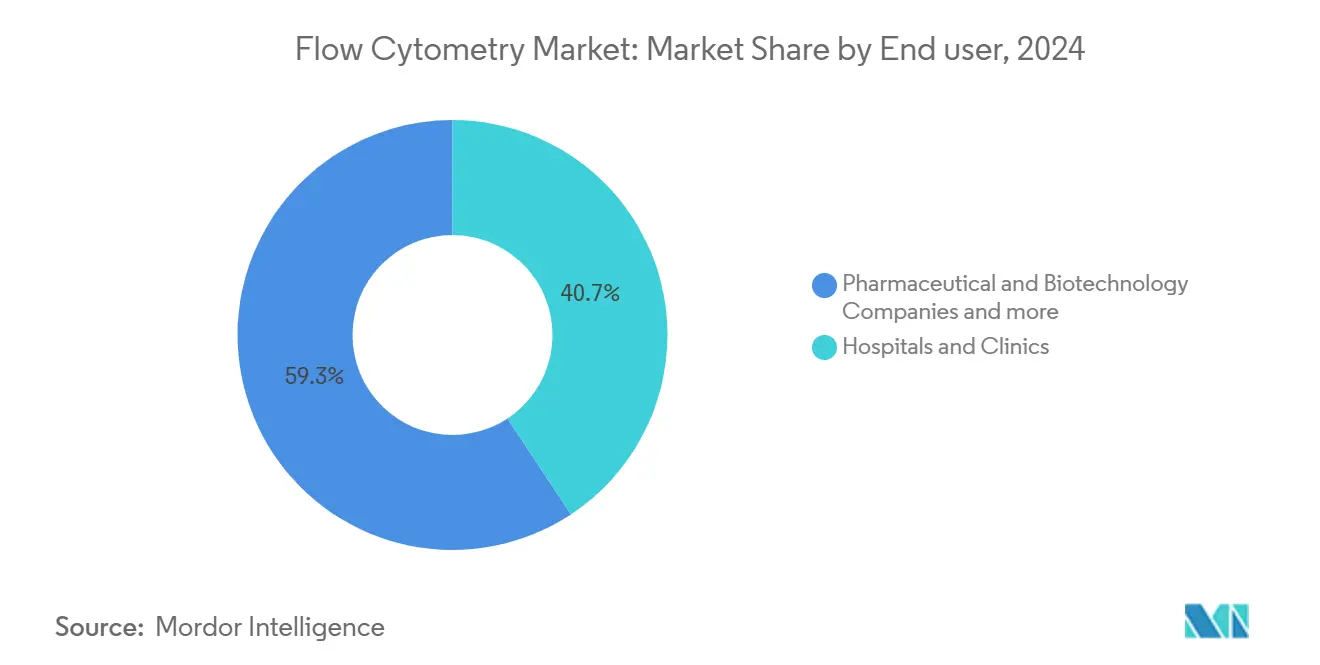
Note: Segment shares of all individual segments available upon report purchase
Geography Analysis
North America contributed the largest share at 41.20% in 2024, aided by mature reimbursement frameworks and deep oncology clinical-trial pipelines. Continuous instrument refresh cycles, clinical laboratory accreditation mandates, and FDA clearance of a next-generation 13-color cytometer have strengthened procurement confidence. National cancer institutes increasingly mandate high-parameter immunophenotyping for cell-therapy protocols, reinforcing reagent consumption and service subscriptions. Vendor collaborations with reference laboratories further speed diffusion of complex assays into mid-tier community hospitals, sustaining the flow cytometry market.
Asia-Pacific is the fastest-growing region, tracking an 8.96% CAGR over 2025–2030. Government funding packages aimed at precision medicine and infectious-disease readiness have stimulated laboratory expansions across China, Japan, and South Korea. A new 50,000-square-foot production site in China illustrates manufacturers' commitment to local demand and global supply-chain resilience. Local biotech start-ups, focused on CAR-T and iPSC therapies, seek full-spectrum profiling to accelerate candidate validation, bolstering the regional flow cytometry market.
Europe maintains steady growth as centralized healthcare systems invest in high-parameter instruments for national cancer screening programs. Regional research grants encourage spectral-flow method development in academic centers, driving reagent diversification. A partnership between a key vendor and Spanish genomics institutions is expected to spawn advanced immunology applications, reinforcing instrument utilisation rates. Compliance with GDPR and evolving IVDR requirements keeps demand high for software modules with robust data-privacy features, channeling additional revenue into the European flow cytometry market.
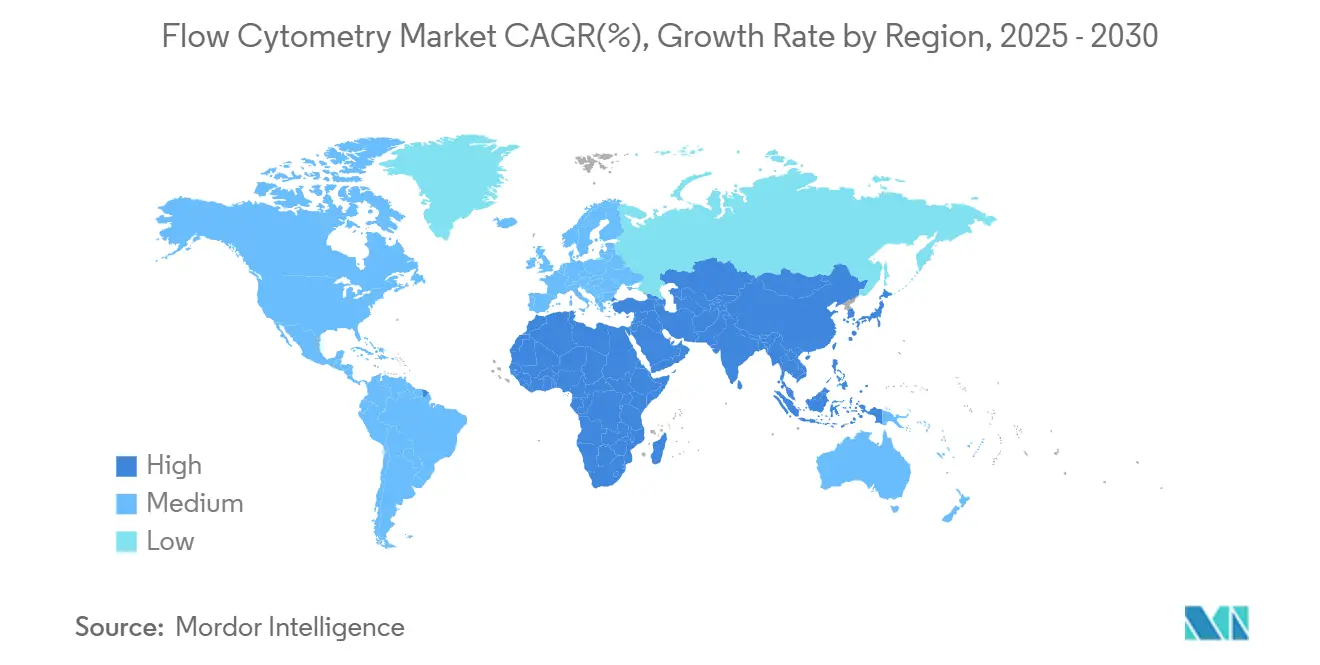
Competitive Landscape
The industry features moderate consolidation. Three integrated suppliers—BD Biosciences, Beckman Coulter, and Thermo Fisher Scientific—hold the largest installed base by bundling instruments, reagents, and informatics. A spectral-platform specialist, Cytek Biosciences, has disrupted legacy business models by unlocking 40-color panels without prohibitive optics costs, prompting incumbents to accelerate their own spectral and image-enabled releases. Competitive positioning now hinges on ecosystem breadth and workflow simplicity rather than detector counts alone.
Partnerships constitute a primary differentiation lever. A July 2024 agreement pairs a diagnostics laboratory giant with an instrument vendor to co-develop companion diagnostics, aiming for synchronized hardware-reagent approvals that embed cytometry within oncology treatment algorithms. Meanwhile, reagent suppliers launch dye libraries engineered for full-spectrum instruments, cementing cross-vendor compatibility and expanding consumable revenues. In 2025, a life-science tools company introduced kit-based antibody-conjugation chemistries that empower labs to build bespoke panels without specialist facilities.
Vendor roadmaps increasingly target usability barriers. AI-enabled panel-design tools and automated quality-control dashboards are being integrated into next-generation instruments, transforming cytometry from specialist-only equipment into routine laboratory analyzers. As manufacturers embed cybersecurity modules to satisfy 21 CFR Part 11 audits, customers reduce procurement friction, and aftermarket subscription revenues expand. Collectively, these competitive vectors sustain investment in R&D and reinforce the long-run trajectory of the flow cytometry market.
Flow Cytometry Industry Leaders
-
Sysmex Corporation
-
Becton, Dickinson and Company
-
DANAHER corporation (Beckman Coulter, Inc.)
-
Bio-Rad Laboratories Inc.
-
Luminex Corporation
- *Disclaimer: Major Players sorted in no particular order
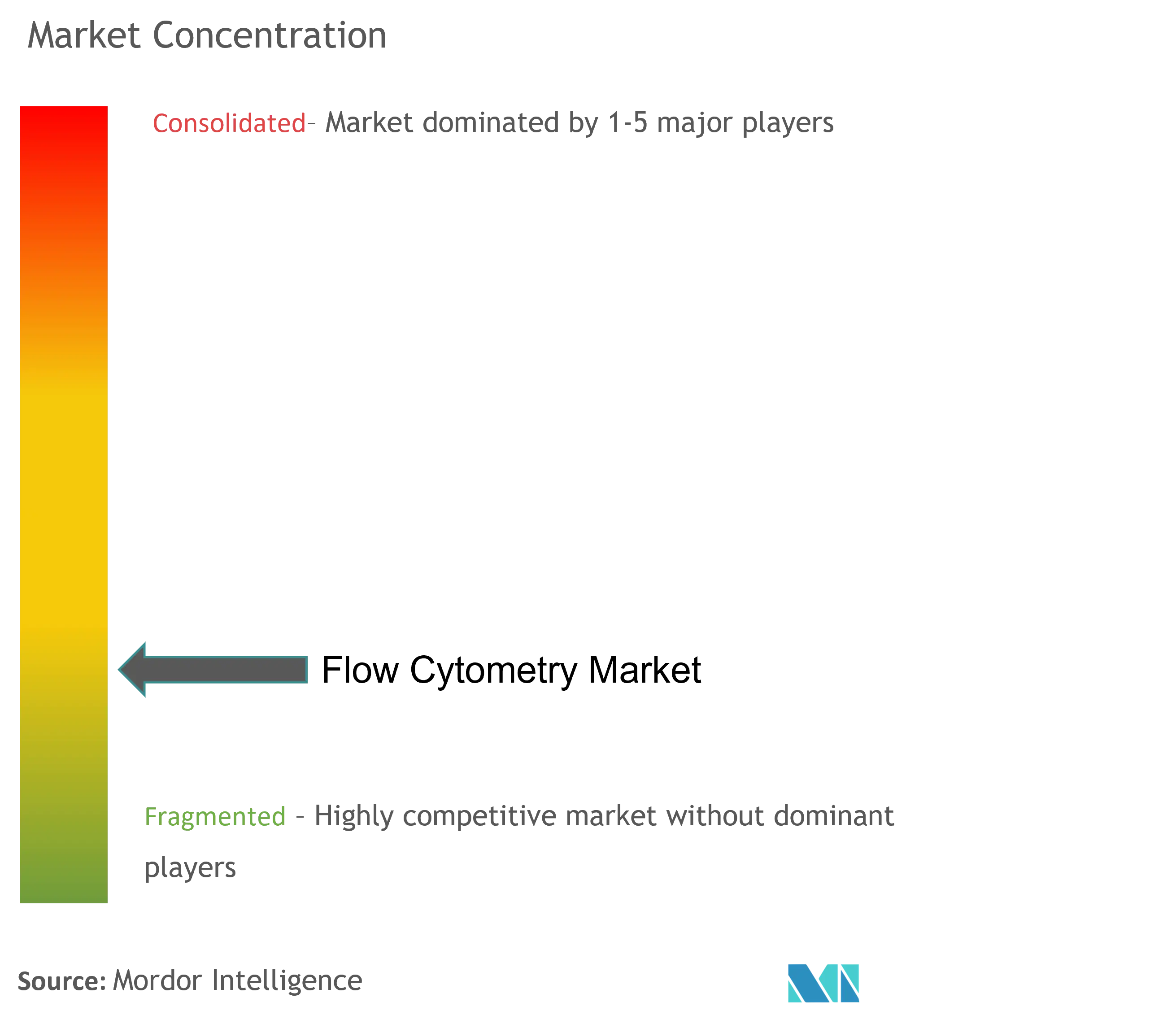
Recent Industry Developments
- February 2025: Bio-Rad Laboratories launched TrailBlazer Tag and TrailBlazer StarBright Dye Label Kits for antibody conjugation, allowing custom high-plex panels for flow cytometry using SpyTag and SpyCatcher technology.
- November 2024: Becton, Dickinson, and Company released BD Research Cloud, a cloud-based software solution that streamlines the flow cytometry workflow to help scientists in a wide range of fields, such as immunology, virology, oncology, and infectious disease monitoring, do better experiments and get results faster.
- July 2024: BD and Quest Diagnostics unveiled a global collaboration to develop flow-cytometry companion diagnostics for cancer and other diseases
Research Methodology Framework and Report Scope
Market Definitions and Key Coverage
Our study defines the global flow cytometry market as all laser, impedance, or acoustic-focused instruments, reagents, software, and paid services that enable single-cell analysis and sorting across research, clinical, and industrial workflows. According to Mordor Intelligence, accessories bundled at installation or sold for workflow optimization are counted within the revenue pool.
We exclude purely image-based cytometers that never use a hydrodynamic flow stream.
Segmentation Overview
- By Product & Service
- Instruments
- Cell Analyzers
- Cell Sorters
- Reagents & Consumables
- Antibodies
- Dyes & Beads
- Kits & Panels
- Software
- Services
- Instruments
- By Technology
- Cell-Based Flow Cytometry
- Bead-Based Flow Cytometry
- Imaging Flow Cytometry
- Acoustic-Focusing Flow Cytometry
- By Application
- Clinical Diagnostics
- Oncology
- Hematology
- Infectious Diseases
- Organ Transplantation
- Drug Discovery & Development
- Stem-Cell Therapy & Regenerative Medicine
- Immunology
- Other Research Applications
- Clinical Diagnostics
- By End-User
- Hospitals & Clinics
- Pharmaceutical & Biotechnology Companies
- Contract Research & Reference Laboratories
- Other End-Users
- By Geography (Value, USD)
- North America
- United States
- Canada
- Mexico
- Europe
- Germany
- United Kingdom
- France
- Italy
- Spain
- Rest of Europe
- Asia-Pacific
- China
- India
- Japan
- South Korea
- Australia
- Rest of Asia-Pacific
- Middle East
- GCC
- South Africa
- Rest of Middle East
- South America
- Brazil
- Argentina
- Rest of South America
- North America
Detailed Research Methodology and Data Validation
Primary Research
Mordor analysts interviewed laboratory directors, hematopathologists, reagent product managers, and procurement leads across North America, Europe, and Asia-Pacific. These talks confirmed installed analyzer counts, reagent pull-through rates, and upcoming capital budgets, letting us refine assumptions and validate early findings.
Desk Research
We began with structured desk work that pulled data from the World Health Organization's GLOBOCAN cancer series, the Centers for Medicare and Medicaid Services procedure files, Eurostat trade codes, and the International Society for Advancement of Cytometry. Regulatory filings in the U.S. FDA 510(k) database and peer-reviewed papers on PubMed mapped technology adoption. Company 10-K reports, investor decks, and curated news feeds from Dow Jones Factiva and D&B Hoovers enriched price bands and shipment clues.
In a second pass, our team retrieved import-export lines from Volza, patent families from Questel, and contract notices in Tenders Info, and then reconciled overlaps before modeling. This list is not exhaustive; many other sources supported data checks and clarification.
Market-Sizing & Forecasting
We applied an integrated top-down and selective bottom-up approach. Starting with production, trade, and installed-base statistics, we rebuilt the global analyzer stock and attached average selling prices and yearly reagent usage to reach the 2025 revenue baseline. Supplier roll-ups and distributor checks validated totals. Core variables include new analyzer shipments, reagent pull-through per test, oncology testing prevalence, stem-cell therapy trial starts, and laboratory capital spending. Multivariate regression, guided by primary-research consensus, projects growth to 2030, while scenario analysis captures reimbursement or regulatory shocks. Gaps in granular shipments were bridged with regional average price-volume proxies gathered during interviews.
Data Validation & Update Cycle
We ensure each draft output passes variance screening, peer review, and senior analyst sign-off. Analysts compare model signals with independent metrics, revisit sources when anomalies surface, and refresh the report annually, issuing interim updates after material events so clients always receive a current view.
Why Mordor's Flow Cytometry Baseline Commands Confidence
Published numbers often differ because firms slice the market in unique ways and refresh at varied cadences, a reality we flag early for clients.
Key gap drivers include competitors omitting imaging or acoustic-focused systems, locking exchange rates to the prior year, or assuming flat reagent usage. This is where Mordor's methodology stands apart; our cadence ties every refresh to new incidence data, real-time ASP shifts, and interview-verified utilization patterns.
Benchmark comparison
| Market Size | Anonymized source | Primary gap driver |
|---|---|---|
| USD 6.75 B (2025) | Mordor Intelligence | None |
| USD 4.68 B (2024) | Global Consultancy A | Narrower product set; imaging and acoustic platforms excluded |
| USD 6.16 B (2024) | Industry Association B | Single-scenario forecast and fixed 2023 currency rates |
| USD 5.71 B (2024) | Trade Journal C | Relies on voluntary disclosures with no reagent pull-through adjustment |
In sum, because we triangulate multiple variables, validate them with frontline practitioners, and refresh swiftly, Mordor's flow cytometry baseline delivers a balanced, transparent, and repeatable reference for decision-makers.
Key Questions Answered in the Report
What is the current size of the flow cytometry market?
The market generated USD 6.75 billion in 2025 and is on track to reach USD 9.78 billion by 2030.
Which region is growing fastest in flow cytometry adoption?
Asia-Pacific leads growth with an expected 8.96% CAGR over 2025–2030 due to expanding biotechnology activity and healthcare investment.
What segment of flow cytometry products is expanding most rapidly?
Software solutions hold the highest growth rate at a 10.34% CAGR, driven by AI-enabled panel design and automated analysis modules.
How are companion diagnostics influencing the market?
Collaborations between instrument makers and reference laboratories are introducing flow-cytometry-based companion diagnostics that accelerate personalized oncology therapies, spurring instrument placements and reagent sales.
Why are reference laboratories gaining share?
Persistent shortages of skilled cytometrists and the complexity of high-parameter datasets are prompting hospitals and drug developers to outsource assays to specialized labs that offer turnkey services.
What technological advance offers the greatest increase in parameter capacity?
Spectral flow cytometry using full-spectrum unmixing now enables simultaneous detection of up to 40 markers, dramatically expanding immunophenotyping depth and driving upgrades within the flow cytometry market.
Page last updated on:
